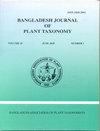从 Matk 和 Rbcl 基因推断孟加拉国 Arecaceae 的分子系统学和分子年代学
IF 0.8
4区 生物学
Q4 PLANT SCIENCES
引用次数: 0
摘要
研究人员对孟加拉国棕榈科 Arecaceae 15 属 30 个物种进行了分子系统学调查,通过邻接法、最大似然法和贝叶斯推断法等多元算法驱动的方法,利用基于质粒的 matK 和 rbcL 基因推断进化关系和分子年代。研究发现,由于 matK 基因的高度可变性,它比 rbcL 基因具有更好的物种鉴别效率。过渡/反转偏倚测试证实了这一发现,因为 matK 的偏倚(2.632)高于 rbcL(2.235)。通过 HYPERMUT 程序可视化核苷酸替换模式,发现 matK 的变异性较高,而 rbcL 的变异性较低。用 matK 构建的系统发生树显示,所有三个亚科(Arecoideae、Coryphoideae 和 Calamoideae)的起源均为单系,而 rbcL 树显示 Coryphoideae 为多系,Arecoideae 和 Calamoideae 为单系。在 matK 树中,属于三个亚科的所有九个科都表现出单系性。发现 matK 拓扑的 Bootstrap 支持率和贝叶斯后验概率均高于 rbcL 拓扑。分子钟测试揭示了 matK 和 rbcL 序列的进化速度相等。分子年代测定法揭示了菖蒲科(Calamoideae)是起源于中生代白垩纪晚期的三个亚科中最古老的亚科(65.75 MYA),而伞形科(Coryphoideae)和芋形科(Arecoideae)则起源于新生代。孟加拉国植物分类学杂志》。30(2):213-232,2023 年(12 月)本文章由计算机程序翻译,如有差异,请以英文原文为准。
Molecular Phylogenetics and Molecular Dating of Arecaceae In Bangladesh Inferred from Matk and Rbcl Genes
A molecular phylogenetic investigation was undertaken for 30 species belonging to 15 genera of the palm family Arecaceae in Bangladesh to infer evolutionary relationships and molecular dating utilizing plastid-based matK and rbcL genes through multifaceted-algorithm driven approaches with Neighbor-Joining, Maximum-Likelihood, and Bayesian Inference methods. The study revealed that matK has better species discrimination efficiency than rbcL gene due to its highly variable nature. Transition/transversion bias test corroborated this finding as matK showed higher bias (2.632) than rbcL (2.235). Nucleotide substitution patterns were visualized via HYPERMUT program, which unveiled higher variability in matK and lower variability in rbcL alignment. Phylogenetic trees constructed with matK revealed monophyletic nature of origin for all the three subfamilies, viz. Arecoideae, Coryphoideae and Calamoideae, while rbcL trees exhibited polyphyly for Coryphoideae and monophyly for Arecoideae and Calamoideae. All the nine tribes belonging to three subfamilies demonstrated monophyletic nature in matK trees. Bootstrap support and Bayesian posterior probability were found to be higher in matK topologies than that of rbcL. The molecular clock test unraveled an equal evolutionary rate for matK and unequal rate for rbcL sequences. Molecular dating approach unveiled Calamoideae to be the most ancient subfamily (65.75 MYA) among the three subfamilies that originated during the Late Cretaceous period in the Mesozoic era, whereas Coryphoideae and Arecoideae were found to have originated in the Cenozoic era. Bangladesh J. Plant Taxon. 30(2): 213-232, 2023 (December)
求助全文
通过发布文献求助,成功后即可免费获取论文全文。
去求助
来源期刊
CiteScore
0.42
自引率
44.40%
发文量
12
审稿时长
6 months
期刊介绍:
Bangladesh is a humid, subtropical country favouring luxuriant growth of microorganisms, fungi and plants from algae to angiosperms with rich diversity. She has the largest mangrove forest of the world in addition to diverse hilly and wetland habitats. More than a century back, foreign explorers endeavoured several floral expeditions, but little was done for non-vasculars and pteridophytes. In recent times, Bangladesh National Herbarium has been carrying out taxonomic research in Bangladesh along with few other national institutes (e.g. Department of Botany of public universities and Bangladesh Forest Research Institute).

 求助内容:
求助内容: 应助结果提醒方式:
应助结果提醒方式:


